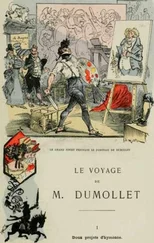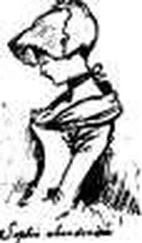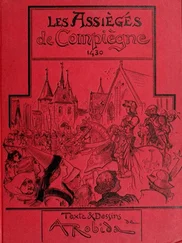Albert Robida - Yester-year; ten centuries of toilette from the French of A. Robida
Здесь есть возможность читать онлайн «Albert Robida - Yester-year; ten centuries of toilette from the French of A. Robida» весь текст электронной книги совершенно бесплатно (целиком полную версию без сокращений). В некоторых случаях можно слушать аудио, скачать через торрент в формате fb2 и присутствует краткое содержание. Жанр: Старинная литература, на английском языке. Описание произведения, (предисловие) а так же отзывы посетителей доступны на портале библиотеки ЛибКат.
- Название:Yester-year; ten centuries of toilette from the French of A. Robida
- Автор:
- Жанр:
- Год:неизвестен
- ISBN:нет данных
- Рейтинг книги:4 / 5. Голосов: 1
-
Избранное:Добавить в избранное
- Отзывы:
-
Ваша оценка:
- 80
- 1
- 2
- 3
- 4
- 5
Yester-year; ten centuries of toilette from the French of A. Robida: краткое содержание, описание и аннотация
Предлагаем к чтению аннотацию, описание, краткое содержание или предисловие (зависит от того, что написал сам автор книги «Yester-year; ten centuries of toilette from the French of A. Robida»). Если вы не нашли необходимую информацию о книге — напишите в комментариях, мы постараемся отыскать её.
Yester-year; ten centuries of toilette from the French of A. Robida — читать онлайн бесплатно полную книгу (весь текст) целиком
Ниже представлен текст книги, разбитый по страницам. Система сохранения места последней прочитанной страницы, позволяет с удобством читать онлайн бесплатно книгу «Yester-year; ten centuries of toilette from the French of A. Robida», без необходимости каждый раз заново искать на чём Вы остановились. Поставьте закладку, и сможете в любой момент перейти на страницу, на которой закончили чтение.
Интервал:
Закладка:
When stone is cut, and twisted, and made almost to flash into magnificent sculptured efflorescence, the more supple textile fabric is cut and twisted and made to effloresce also. The tall head-dresses which we call extravagant are the tapering tops of the turrets which rise from everywhere towards the sky. Everything is many-coloured, the peoi^le of those days loved bright tints, the whole gamut of the yellows, reds, and greens is employed.
At a later date, costume, simultaneously with architecture, let itself out more freely. The Renaissance had come with its ampler and less rigid fashions; novelty was sought in the old. Italy acted upon dress as she acted upon building; everything, even to the princes' panoply of war or state, and the iron ' harness ' of the rich nobles, was made in the antique forms, and covered with ornaments of Roman design.
The severity, indeed we may call it the gloom, of the fashions at the end of the sixteenth century, was also a characteristic of the edifices of a troubled epoch.
The ponderously wearisome and sumptuous palace of Versailles, the big dull hôtels whose
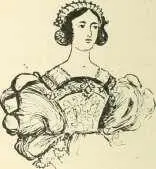
Eenaissance.
architecture embodies morose conceit, are entirely appropriate coverings for the enormous and solemn wigs of the great King, and the starched tight-laced bodices and stiff ' heads ' of Madame de Maintenon.
After the tedious end of the seventeenth century comes the eighteenth ; the pompous
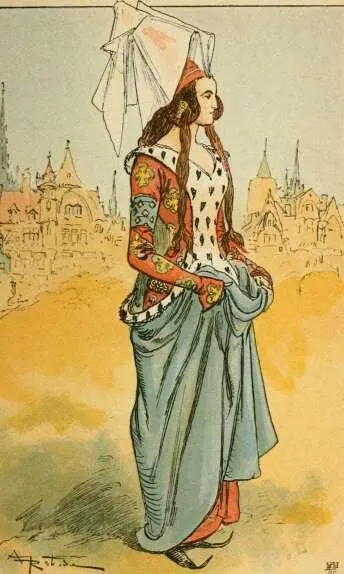
NOBLE DAME, FIN DU XIV SIECLE.
and the solemn are discarded at the same time by both dress and architecture, ' rococo ' toilettes, and furbelowed buildings—it is all one.
At a later date, when the people of the
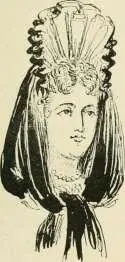
Ululer the Great Kiug.
Revolutionary Period and the First Empire arrayed themselves in Greek and Roman fashion, public buildings and houses did the same. From 1840 to 1860, a period of transition and expectation, both fashions and buikliDgs were absolutely commonplace, and destitute of any style wliatsoever.
Lastly, in our own time, a period of archaeological research and general rummage, of experiments and reconstitution, a period of imitation rather than imagination and creation, we again observe architecture and fashion keeping step, grojjing together in the clothes-chests of the past, trying-on all styles, one after another, falling in love with each period in succession, and adopting its forms only to throw them aside immediately. Let us then do as our time does, let us too ransack the clothes-chests of the past in our search for the pretty things and the oddities of long long ago.
Beyond a certain period authentic documents are scarce, and we have to be satisfied with suppositions. Who shall tell us truly what were the costumes, the fashions, and the general aspect of life as presented by them, in tlie Merovingian and Carlovingian days, when—
Four harness'd oxen, heavy-hoofed and slow, Through Paris dragged the King, a lazy show. '
Who shall depict for us the finery of those obscure periods ? Finery there was, in spite of their rudeness and barbarism, for we find the old chroniclers in their writings already denouncing the unbounded extravagance of women.
Who shall paint for us the ladies of the time of Charlemagne, and instruct us in the modish ways of the tenth century ? The few statues which have come down to us, more or less mutilated, constitute our only documents ; we must content ourselves with them, and with the vague indications contained in the rude illustrations of the manuscripts of that period, so much earlier than the superb illuminations with which the artists of the Middle Ages enriched the world in a later day.
Our first Fashion-plate, then, will be some cathedral door, or statue from a tomb, that has Quatre hœufs attelés, d'un pas tranquille et lent, Promenaient dans Paris le monarque indolent.
YESTER-YEAR.
miraculously escaped the ravages of time and the hammer of the iconoclasts, whether of ' the Religion ' or the Revolution.
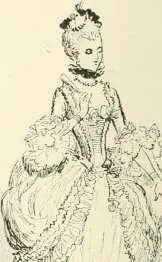

Uuder Louis (^>uiuze.
At a later period, miniatures, painted wimlows, and tapestries, will furnish us with more complete and certain information, an(i far more precise figures ; ' documents ' will abound.
Besides, in the fourteenth century the actual fashion-plate existed. It had not adopted the ' gazette ' shape (that has been in use for a hundred years only), but it was a journal of fashion nevertheless. Instruction in tho mode travelled, under the form of dolls Avearing model costumes, from one country to another, esi^ecially from Paris.
Paris already held the sceptre, and ruled over fashion, although not as she now rules from pole to pole, from the frozen shores of America to Australia—where bits of bone passed through the nasal cartilage were the only homage paid to vanity little more than fifty years ago—from the courts of the Rajahs of India to the seraglio of the Grand Turk, and the palace of Her Majesty the Empress of the Flowery Land.
In the middle ages, certain great ladies of our dear little corner of Europe, used to present each other with small dolls, dressed in the latest fashion by ' cutters/ dressmakers and tailors whose names have not come down to posterity.
Thus, on great occasions, the duchess in her distant château on the Breton ' Landes,' or the Margravine perched upon her rock on the Rhine border, would learn more or less rapidly what was the latest feat of fashion in great centres of luxury and elegance, such as the Court of Paris or the Court of Burgundy. These were rivals in novelty and display, as we learn from the accounts of expenditure that have been brought to light, with the details of the sumptuous doings which dazzled contemporaries, and are recorded by all the chroniclers of the time.
Certain important towns also received the decrees of fashion by similar means. For centuries, Venice, another centre of the sumptuary arts, and a connecting link between Eastern commerce and Western luxury, annually imported a Parisian doll. It was of imme-morial custom to exhibit the waxen image cf a Parisian lady, attired in the last fashion, on Ascension Day, under the arcades of tlic ' Merceria,' at the end of the Piazza of St. Mark, as " the toilette of the year," for the edification of the noble Venetian dames who eagerly flocked to the show.

Uudcr Louis XII.
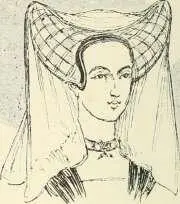
Escofiioii.
III.
THE MIDDLE AGES.
The painted and tatooed Gauls—The first corsets and tlie first false-plaits—The first sumptuary edicts— Byzantine influence—' Bliauds,' surcoats, and ' cottes hardies '—Pictorial and emblazoned gowns—The ordinances of Philip the Fair—' Hennins ' and ' Escoffions '—The Crusade of Brother Thomas Connecte against the ' hennin '—The ' Lady of Beautj'.'
Читать дальшеИнтервал:
Закладка:
Похожие книги на «Yester-year; ten centuries of toilette from the French of A. Robida»
Представляем Вашему вниманию похожие книги на «Yester-year; ten centuries of toilette from the French of A. Robida» списком для выбора. Мы отобрали схожую по названию и смыслу литературу в надежде предоставить читателям больше вариантов отыскать новые, интересные, ещё непрочитанные произведения.
Обсуждение, отзывы о книге «Yester-year; ten centuries of toilette from the French of A. Robida» и просто собственные мнения читателей. Оставьте ваши комментарии, напишите, что Вы думаете о произведении, его смысле или главных героях. Укажите что конкретно понравилось, а что нет, и почему Вы так считаете.

